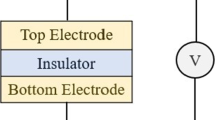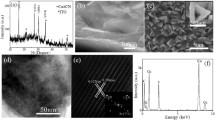Abstract
The fabrication and the performance of PMMA resistive switching device have been studied by using FR-4 (copper), PMMA (poly methyl methacrylate) and aluminum as the active anode, the solid electrolyte and the inert cathode respectively. By etching the copper surface with the acid solution [4HNO3 + 11H3PO4 (98 %) + 5CH3COOH] at 60 °C for 2 min, a good performance of Cu/PMMA/Al device, which can switch until 2300 cycles, has been realized. The spin rate for forming the PMMA coating plays a decisive role in the performance of Cu/PMMA/Al device. The best performance of the Cu/PMMA/Al device was obtained only when the spin rate of deposition of PMMA reached 4000 rpm (low thickness).








Similar content being viewed by others
References
Guan WH, Long S, Liu Q, Liu M, Wang W (2008) Nonpolar nonvolatile resistive switching in Cu Doped ZrO2. Electron Dev Lett IEEE 29(5):434–437
Guo X, Schindler C, Menzel S, Waser R (2007) Understanding the switching-off mechanism in Ag+ migration based resistively switching model systems. Appl Phys Lett 91(13):133513
King YC, King TJ, Hu CM (1998) MOS memory using germanium nanocrystals formed by thermal oxidation of Si1−x Gex. In: Electron devices meeting, 1998. IEDM ‘98. Technical Digest, International pp 115–118
Kozicki MN, Balakrishnan M, Gopalan C, Ratnakumar C, Mitkova M (2005) Programmable metallization cell memory based on Ag–Ge–S and Cu–Ge–S solid electrolytes. In: Non-volatile memory technology symposium, 2005, 7 pp 89
Kozicki MN, Gopalan C, Balakrishnan M, Mitkova M (2006) A low-power nonvolatile switching element based on copper–tungsten oxide solid electrolyte. Nanotechnol IEEE Trans 5(5):535–544
Liu T (2013) Nonvolatile and Volatile resistive switching-characterization, modeling, memristive subcircuits. Virginia Tech, Virginia
Pyun M, Choi H, Park JB, Lee D, Hasan M, Dong R, Jung SJ, Lee JY, Seong DJ, Yoon J, Hwang HS (2008) Electrical and reliability characteristics of copper-doped carbon (CuC) based resistive switching devices for nonvolatile memory applications. Appl Phys Lett 93(21):212907
Sakamoto T, Sunamura H, Kawaura H, Hasegawa T, Nakayama T, Aono M (2003) Nanometer-scale switches using copper sulfide. Appl Phys Lett 82(18):3032–3034
Schindler C, Thermadam SCP, Waser R, Kozicki MN (2007) Bipolar and unipolar resistive switching in Cu-doped SiO2. Electron Dev IEEE Trans 54(10):2762–2768
Wang Z, Griffin PB, McVittie J, Wong S, McIntyre PC, Nishi Y (2007) Resistive switching mechanism in Zn x Cd1−x S nonvolatile memory devices. Electron Dev Lett IEEE 28(1):14–16
Waser R, Aono M (2007) Nanoionics-based resistive switching memories. Nat Mater 6(11):833–840
Waser R, Dittmann R, Staikov G, Szot K (2009) Redox-based resistive switching memories-nanoionic mechanisms, prospects, and challenges. Adv Mater 21(25–26):2632–2663
Yang YC, Pan F, Liu Q, Liu M, Zeng F (2009) Fully room-temperature-fabricated nonvolatile resistive memory for ultrafast and high-density memory application. Nano Lett 9(4):1636–1643
Yang YC, Pan F, Zeng F (2010) Bipolar resistance switching in high-performance Cu/ZnO:Mn/Pt nonvolatile memories: active region and influence of Joule heating. N J Phys 12(2):023008
Yoon J, Hyejung C, Lee D, Park JB, Lee JY, Seong DJ, Yongkyu J, Chang M, Jung S, Hwang H (2009) Excellent switching uniformity of Cu-doped MoO x /GdO x bilayer for nonvolatile memory application. Electron Dev Lett IEEE 30(5):457–459
Zhai MH, Yin KB, Shi L, Yin J, Liu ZG (2007) Conductance switching effect in the Cu/CuI0.76S0.14/Pt structure. J Phys D Appl Phys 40(12):3702
Acknowledgments
This work is supported by Institute of Electronics of the South Montpellier (IES) of the group of M2A, as well as National Natural Science Foundation of China (No. 51301133) and Scientific Research Program Funded by Shaanxi Provincial Education Department (No. 2013JK0907).
Author information
Authors and Affiliations
Corresponding author
Rights and permissions
About this article
Cite this article
Jian, J., Chang, H., Vena, A. et al. Study and design of resistive switching behaviors in PMMA-based conducting-bridge random-access memory (CBRAM) devices. Microsyst Technol 23, 1719–1725 (2017). https://doi.org/10.1007/s00542-015-2754-6
Received:
Accepted:
Published:
Issue Date:
DOI: https://doi.org/10.1007/s00542-015-2754-6




